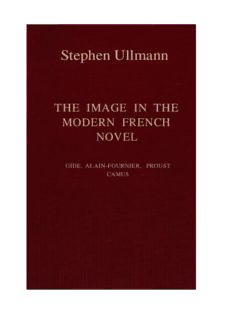
The Image in the modern French Novel: Gide, Alain-Fournier, Proust, Camus PDF
Preview The Image in the modern French Novel: Gide, Alain-Fournier, Proust, Camus
Stephen Ullmann THE IMAGE IN THE MODERN FRENCH NOVEL GIDE, ALAIN-FOURNIER, PROUST CAMUS THE IMAGE IN THE THE IMAGE IN THE MODERN FRENCH NOVEL GIDE, ALAIN-FOURNIER, PROUST MODERN FRENCH CAMUS / BY STEPHEN ULLMANN, Ph.D., D.Litt. Professor of Romance Philology in the NOVEL University of Leeds NEW YORK BARNES AND NOBLE INC. * 1963 GIDE, ALAIN-FOURNIER, PROUST CAMUS . BY STEPHEN ifLLMANN, PH.D., D.LITT. " ProJessor ojRomam:e Philology in the . University ojLeeds NEW YORK BARNES AND NOBLE INC. 1963 , . • f ~. .' • I d) ~-<f I / 9te. 3 ^rr*d f ;- Vf, ~'~ 1439578 CONTENTS Preface page vii CONTENTS I The development of Gide's imagery 1 II The symbol of the sea in Le Grand Meaulnes 99 III The metaphorical texture of a Proustian novel 124 PreftUe page vii I The development of Gide's imagery 1 II The symbol of the sea in Le Grand Meaulnes 99 III The metaphorical texture of a Proustian novel 1240 IV The two styles of Camus 289 Index 807 PREFACE author will rely on similes and metaphors to formulate the main themes of his novel with the maximum of precision, concreteness and expressive force. Imagery may therefore take the critic by a straight route to the very core of the work of art, and the metaphors arising around these central themes may develop into major symbols. Thirdly, images are a most effective means of portrayal through style; they are symptomatic of the per- sonality of the characters who use them. These oblique effects are particularly important in novels told by a narrator. Most of the works discussed in these studies fall into this category. The main purpose of this book, as of its predecessor, is to bridge the gap between linguistics and literary criticism. I would not go so far as to claim with Mr Martin Turnell that ' the study of the French novel is primarily a study of the alterations which have taken place in the French language and of the novelists' use of their resources ' ; but it is undoubtedly true that the style of a novel is an integral and vitally important part of its substance. The narrative technique of an author, his creative and experimental handling of the language, is an essential element of the ' craft of fiction ' about which Percy Lubbock wrote nearly forty years ago: 'There is nothing more that can be usefully said about a novel until we have fastened upon the question of its making and explored it to some purpose.... It seems vain to expect that discourse upon novelists will contain anything new for us until we have really and clearly and accuratel0y seen their books.' 6 I am grea3tly indebted to the University of Leeds, and in 6 particular1 to the Vice-Chancellor, Sir Charles R. Morris, for 0 a generou18s contribution towards publication costs, and to Pro- 0 fessor L9. C. Harmer for his friendly interest and encouragement. 8 My sinceru.e thanks are also due to the following scholars for valu- w able infor7/mation or advice: Dr T. V. Benn, Professor Germaine Brée, P2rofessor G. T. Clapton, Dr J. Cruickshank, Dr G. Hains- 0 wSToErth,P DHrnet/2 AE. NN oUaLch,L MrM BA. S.N PNage, and Mr Francis H. Scarfe. Leedse. dl vin n a h p://hdl.oogle T / htte#pd-g Ms 3-07-01 19:20 Gust.org/access_u n 201athitr oh an) ww. gw chip:// sity of Mied / htt Univerdigitiz vidjf (oogle- aG d for dmain, eo neratblic D eu GP
Description: